|
This is a metal based two-part epoxy. I have found nothing stronger for assembling miniatures. It is a great gap filler and can be carved or filed to shape once it has cured. I'm almost out... time to run to the store. You should be able to find this at any hardware or automotive store or Wal-Mart-type place. |
 |
|
This is one of the putties that miniature sculptors use. It can be a bit expensive if you're buying the Excelsior or Games Workshop labels. I use this for filling bases and gaps left by my customizations. Always wet your fingers (and tools) with water when working with it to keep it from sticking. You can get great base textures by stabbing/sculpting it with a toothpick, other tools, or various grains of sandpaper. When using sandpaper be sure to put a good coat of water over the green stuff first. Press it on and the sandpaper should pull right off, leaving a great texture. |
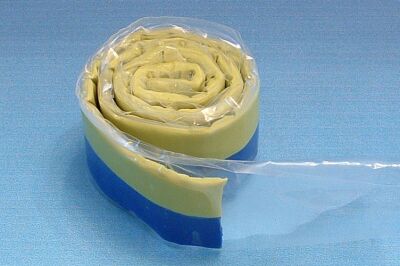 |
|
I don't even use this stuff anymore. I shake too much and the instant set tendency doesn't work well with me. My bottles also dried out long before they were empty. It is important to use gap filling glues. Zap-a-Gap is one name I hear mentioned often, but there are many others. Just read the labels. A common misconception about super glue is that it sets instantly at full strength. It does not. It sets instantly or within a few seconds but requires a good amount of time for full strength--read the label. This is important to note as you are building because some parts require a full strength bond before you can add to them. I have heard that super glue makes a great base filler when used with an accelerator (Zip-Kicker). Simply fill the base and spray it with the accelerator--instantly solidified. |
|
|
May seem a little odd, but this is one hell of a good (and cheap) base filler. Don't try to attach a mini to this, just use it to fill around a solid base. It is water soluble, very easy to work with, and does not shrink like normal spackle. I picked mine up at Wal-Mart but it (or similar) should be widely available. |
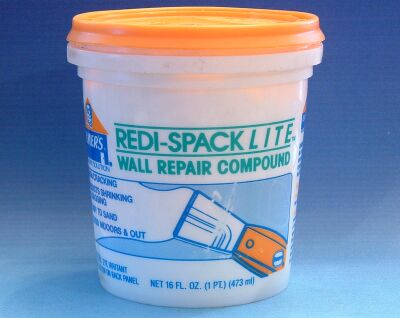 |
|
Sprue cutters (left) are also known as flush cutters. One side is angled and one side flat. This allows them to cut very close to a flat surface. I use them to remove parts from the sprue or to get a flat cut for conversions. Do not try cutting wire with them--they are soft and you will ruin the blades. Wire cutters (right) are also known as dikes (diagonal cutters). I use these for heavy cutting--pins, thick bases, and antenna wire. Always wear safety glasses when using these tools or at least cover the area with your hand. They do not actually cut anything... they pinch the object with a wedge until it breaks. This means that there may be tiny part flying around. Some too small to see. I cut a piece of wire while outside. I had both ends clamped, but (thanks to the sunlight) caught the glint if a tiny particle launching past my head. This thing was microscopic but would've done some painful damage to my eyes. |
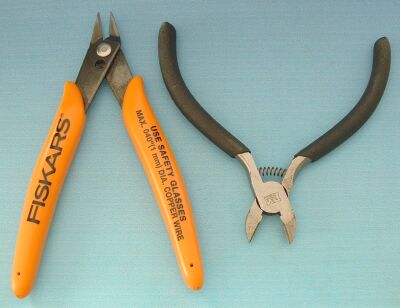 |
|
These can be a modeler's best friend. The straight jaw (top) has a smooth surface while the curved jaw (bottom) is rough like a pliers. Both of these are locking clamps. I use them for holding the ends of wires or pins when cutting and general handling of the pins. The smooth jaws are also handy for bending small parts without marring the surface. You may have difficulty locating a set of these, but it never hurts to ask at your doctor's office or a hospital first. Then maybe a model shop. Acquiring mine involved a foot of fresh snow, lots of alcohol, a football game, a 4x4 steel pole for a swing set, the back of my head, more alcohol, a bandage, pizza, an hour at the bar for more alcohol, and finally a walk to the emergency room for stitches and pain killers. I had my wits about me enough to ask for the pack of surgical tools. They were disposable after all. |
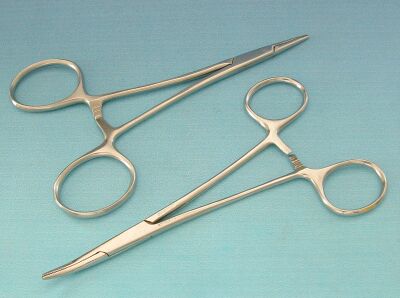 |
|
These are my tools for cleaning up mold lines and flash. Various shaped needle files will get into nearly any area. I use the wire brush to "dust" metal debris from filing and to put a final polish on a curved area. The emery board is good for a final polish on flat areas like hex bases. |
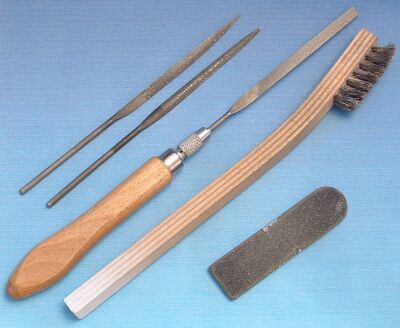 |
|
When miniatures are cast, the rubber mold is coated with a material that prevents the rubber from sticking to the metal. Combine this with the sweat and oils from handling and a miniature is practically teflon coated. How are glue and paint supposed to stick to that? Once I have filed down the mold lines & flash and scored joints, I scrub down all of the pieces with vinegar and allow them to air dry. This cuts though (removes) the mold residue and oils from handling. I scrub it down again once assembly is complete. This works well as a pre-primer for painting. You can substitue mild (and clean) dishwater for the vinegar if you wish. I prefer vinegar because it seems to dry faster. The acid in vinegar may react with the metal and discolor parts of it. Don't worry, it doesn't hurt anything. |
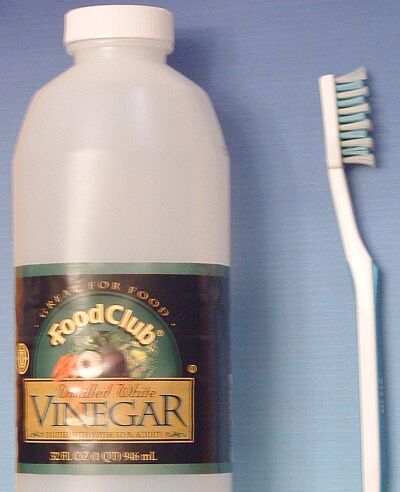 |
|
Various types of putty have become indispensible helping me assemble minis. Never again will I have to hold two pieces together for 5, 10 or 20 minutes while the glue tries to decide if it wants to set. These putties are tacky enough to hold parts on their own while still being easy to remove. Super Sculpey (or Sculpey III) has become my "putty" of choice. It is solid enough to hold a heavy part but soft enough to form easily to that same part. It is less tacky than Poster Putty (Blue-Tac), making it a bit safer to use with more fragile parts. The brick pictured cost me $10 at a craft store and will last me forever. Poster Putty (Blue-Tac) is available almost everywhere. This was the first putty I ever used for assembling a miniature. The only real reason I switched to Sculpey was because Poster Putty is a little too tacky for some situations. In tight areas sometimes a small chunk will cling to the mini, requiring some effort to remove. I also had it tear an arm off that I had just glued (with super glue) in place as I tried to remove the support. I do still use Poster Putty when it comes to painting. A ring of it on a bottle cap will hold a based miniature well enough so that I can use the bottle for a handle. |
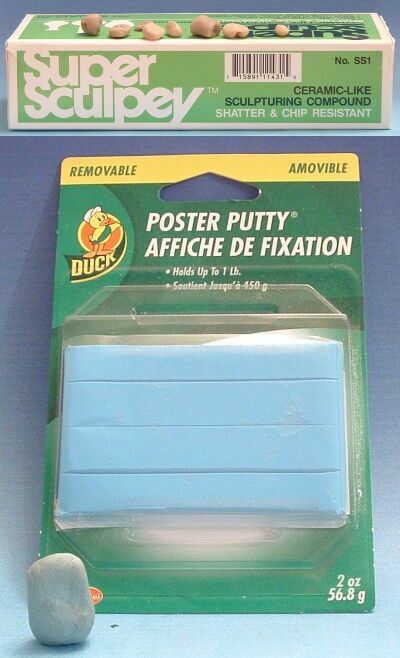 |
|
Besides the actual quality of the paint, IWM bottles themselves are a favorite of mine for assembling. They are a great height and form a very straight line from top to bottom. This allows me to use them (and a spot of putty) as a stable support for off balance pieces while the glue dries. |
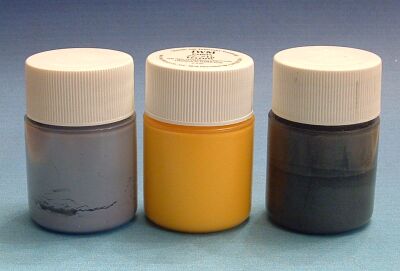 |
|
These are a must have. Not necessarily because nearly every mini needs to be pinned, but because nearly every mini needs to have holes drilled for antenna. If you're going to build and paint a mini... don't forget the antenna. Each of these came with four chuck sizes but I seldom use more than one. The lower vise has a swivel on the back that saves a lot of wear and tear on my hand. |
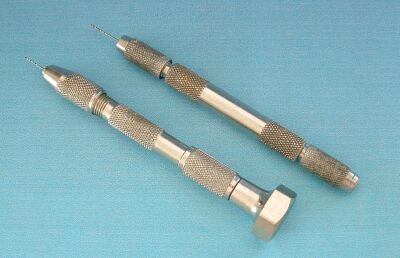 |
|
These are the primary sizes I use. #76 (.020") for antenna holes using the antenna wire that used to come with the minis. #72 (.025) for pin holes. That size will vary depending on what I want to use for pins (see pins below). They come two to a pack for around $2.25 at most hobby shops. (Looks like I need to pick up some more #76's...) I also use larger bits for boring out weapon barrels. Those sizes will obviously vary as well, but most I have found in a good bit set for my power drill. |
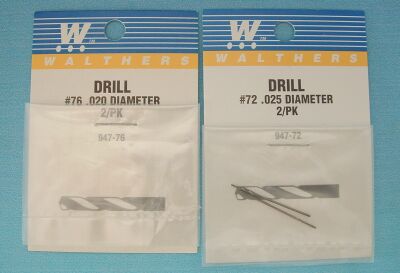 |
|
These are probably the most varied materials you can use. Find a size that works for you and go with it. I happened to have some of these lying around and started using them. Paper clips and various diameters of metal rod/tubing also work. |
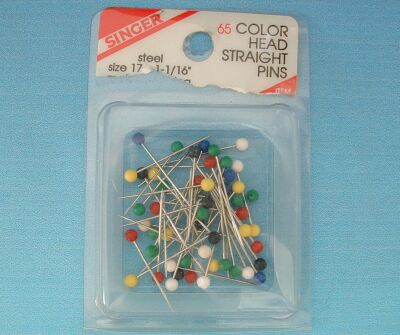 |